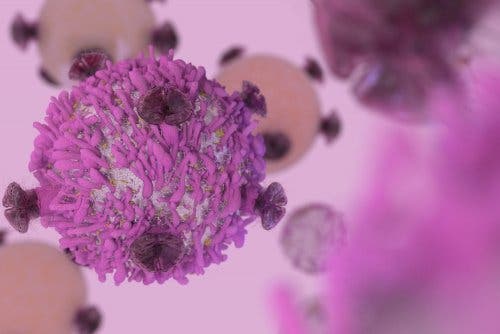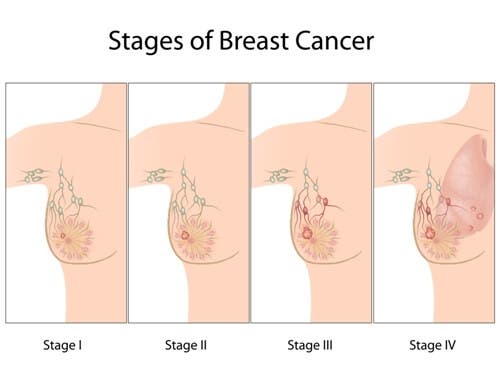The Development of Breast Cancer

Breast cancer is the second most common type of cancer in women and, although 80% manage to defeat it, there’s still a long way to go to achieve less aggressive and more effective treatments. Knowing the development of breast cancer is essential to achieve this goal in the fight against breast cancer.
The origin of breast cancer
Breast cancer begins after the abnormal growth of breast cells that cause a tumor to manifest. An alteration in the DNA of these cells initiates an abnormal expression of certain proteins, which act as carcinogens or initiators of the tumor. These proteins are estrogens, prolactin, and progesterone.
Several factors can trigger a carcinogenic process. It should be noted that the development of breast cancer isn’t due to one of them in particular but to the concurrence of several of them. Highlighting the importance of genetic components:
- Firstly, spontaneous mutations.
- Also, genetic inheritance.
- Likewise, endogenous and exogenous estrogens.
- Finally, chemical and physical carcinogens.

Throughout this process, knowing the biology of breast cancer is essential to understand its development and to be able to develop better treatments to attack cancer cells. Dr. Eva Ciruelos, president of the SOLTI Breast Cancer Research Group and medical oncologist at HM hospitals says:
“The treatment of breast cancer in multidisciplinary teams is essential. It’s the way forward within the history of each patient’s disease.”
What is carcinogenesis?
Carcinogenesis is the set of phenomena that determine the appearance of a tumor and the stages of cancer development. In the case of breast cancer, we can summarize them as follows:
- Firstly, risk factors, inheritance, and estrogens cause a mutation in the DNA of breast cells.
- Secondly, these DNA mutations, whether spontaneous or not, produce alterations during the replication of the genetic material.
- Likewise, consequently, RNA, which is the intermediate molecule to obtain a protein from DNA, is incorrect and will make abnormal proteins.
- Finally, an increase in the expression of oncogenes, combined with the low activity of suppressor genes, will contribute to an increase in the number of tumor cells.
These abnormal cells don’t follow the same growth pattern as healthy cells. Its mortality rate is much lower, so we could speak of immortal cells. As a result, a tumor of different considerations appears based on the time of its detection and, if it’s very late, other organs may be affected. In these cases, we’d speak of metastasis.
The stages of breast cancer
Dr. Dimas Hernández, professor at the José María Vargas University in Caracas, divides the development of tumors into the following points: “We can separate them into carcinogenesis, autocrine and paracrine secretion, growth factors, suppressor genes and oncogenes (HER-2), signaling pathways, invasion, and metastasis.”
Start of the tumor
Once the carcinogenic process begins, causing breaks or defects in DNA repair, the rest of the stages described by Dr. Hernández take place. During autocrine secretion, the tumor cell produces factors to increase its growth rate, regardless of external growth signals. And during paracrine secretion, they act on neighboring cells releasing another growth factor. All this contributes to tumor growth.

We already know that genes are in charge of controlling all the processes that take place inside cells. In the case of suppressor genes, they’re in charge of preventing tumor cells from proliferating. However, if they’ve been altered, this protective mechanism disappears. On the other hand, oncogenes, such as HER-2, due to their high number of mutations, induce the formation of cancer.
The spread of the disease
There must be a communication system between all these components so that they can act in a coordinated manner. These molecules make up what are called “signaling pathways.”
Among the most important is the one formed by estrogens and their receptors. This hormone is capable of producing genotoxic agents that act as carcinogens. mTor is another of these pathways, which insulin and stress activate.
Last but not least, there are the processes of invasion and metastasis. They’re both very complex, since the metastatic cell must separate from the tumor and reach the lymphatic or blood system, escape the control of the immune system and macrophages, and develop a new tumor in another organ.
“A seed needs good soil to develop and not all tumors give good seeds, nor are all organs good soil for them to grow.”
– Dr. Dimas Hernández –
Conclusions
The intense scientific work to describe cellular signaling processes involved in tumor processes is part of the process in order to subclassify tumors. Designing more specific treatments prevents invasive developments, increasing the life expectancy of these women. Without research, there’s no development, and without development, there’s no cure.
Breast cancer is the second most common type of cancer in women and, although 80% manage to defeat it, there’s still a long way to go to achieve less aggressive and more effective treatments. Knowing the development of breast cancer is essential to achieve this goal in the fight against breast cancer.
The origin of breast cancer
Breast cancer begins after the abnormal growth of breast cells that cause a tumor to manifest. An alteration in the DNA of these cells initiates an abnormal expression of certain proteins, which act as carcinogens or initiators of the tumor. These proteins are estrogens, prolactin, and progesterone.
Several factors can trigger a carcinogenic process. It should be noted that the development of breast cancer isn’t due to one of them in particular but to the concurrence of several of them. Highlighting the importance of genetic components:
- Firstly, spontaneous mutations.
- Also, genetic inheritance.
- Likewise, endogenous and exogenous estrogens.
- Finally, chemical and physical carcinogens.

Throughout this process, knowing the biology of breast cancer is essential to understand its development and to be able to develop better treatments to attack cancer cells. Dr. Eva Ciruelos, president of the SOLTI Breast Cancer Research Group and medical oncologist at HM hospitals says:
“The treatment of breast cancer in multidisciplinary teams is essential. It’s the way forward within the history of each patient’s disease.”
What is carcinogenesis?
Carcinogenesis is the set of phenomena that determine the appearance of a tumor and the stages of cancer development. In the case of breast cancer, we can summarize them as follows:
- Firstly, risk factors, inheritance, and estrogens cause a mutation in the DNA of breast cells.
- Secondly, these DNA mutations, whether spontaneous or not, produce alterations during the replication of the genetic material.
- Likewise, consequently, RNA, which is the intermediate molecule to obtain a protein from DNA, is incorrect and will make abnormal proteins.
- Finally, an increase in the expression of oncogenes, combined with the low activity of suppressor genes, will contribute to an increase in the number of tumor cells.
These abnormal cells don’t follow the same growth pattern as healthy cells. Its mortality rate is much lower, so we could speak of immortal cells. As a result, a tumor of different considerations appears based on the time of its detection and, if it’s very late, other organs may be affected. In these cases, we’d speak of metastasis.
The stages of breast cancer
Dr. Dimas Hernández, professor at the José María Vargas University in Caracas, divides the development of tumors into the following points: “We can separate them into carcinogenesis, autocrine and paracrine secretion, growth factors, suppressor genes and oncogenes (HER-2), signaling pathways, invasion, and metastasis.”
Start of the tumor
Once the carcinogenic process begins, causing breaks or defects in DNA repair, the rest of the stages described by Dr. Hernández take place. During autocrine secretion, the tumor cell produces factors to increase its growth rate, regardless of external growth signals. And during paracrine secretion, they act on neighboring cells releasing another growth factor. All this contributes to tumor growth.

We already know that genes are in charge of controlling all the processes that take place inside cells. In the case of suppressor genes, they’re in charge of preventing tumor cells from proliferating. However, if they’ve been altered, this protective mechanism disappears. On the other hand, oncogenes, such as HER-2, due to their high number of mutations, induce the formation of cancer.
The spread of the disease
There must be a communication system between all these components so that they can act in a coordinated manner. These molecules make up what are called “signaling pathways.”
Among the most important is the one formed by estrogens and their receptors. This hormone is capable of producing genotoxic agents that act as carcinogens. mTor is another of these pathways, which insulin and stress activate.
Last but not least, there are the processes of invasion and metastasis. They’re both very complex, since the metastatic cell must separate from the tumor and reach the lymphatic or blood system, escape the control of the immune system and macrophages, and develop a new tumor in another organ.
“A seed needs good soil to develop and not all tumors give good seeds, nor are all organs good soil for them to grow.”
– Dr. Dimas Hernández –
Conclusions
The intense scientific work to describe cellular signaling processes involved in tumor processes is part of the process in order to subclassify tumors. Designing more specific treatments prevents invasive developments, increasing the life expectancy of these women. Without research, there’s no development, and without development, there’s no cure.
All cited sources were thoroughly reviewed by our team to ensure their quality, reliability, currency, and validity. The bibliography of this article was considered reliable and of academic or scientific accuracy.
- ABC salud. (15 octubre 2018).Juntas contra el cáncer: entrevista a Eva Ciruelos [entrevista en medio digital]. Recuperado de: www.diagnosticsnews.com
- Hernández D. (septiembre 2016) Biología del cáncer de mama. Revista venezolana de oncología, vol 28, núm. 3 ISSN:0798-0582, 2016, pp 188-200. Recuperado de: www.redalyc.org
- AECC. (2018). Datos del cáncer de mama [artículo en web]. Recuperado de: ww.aecc.es
This text is provided for informational purposes only and does not replace consultation with a professional. If in doubt, consult your specialist.








